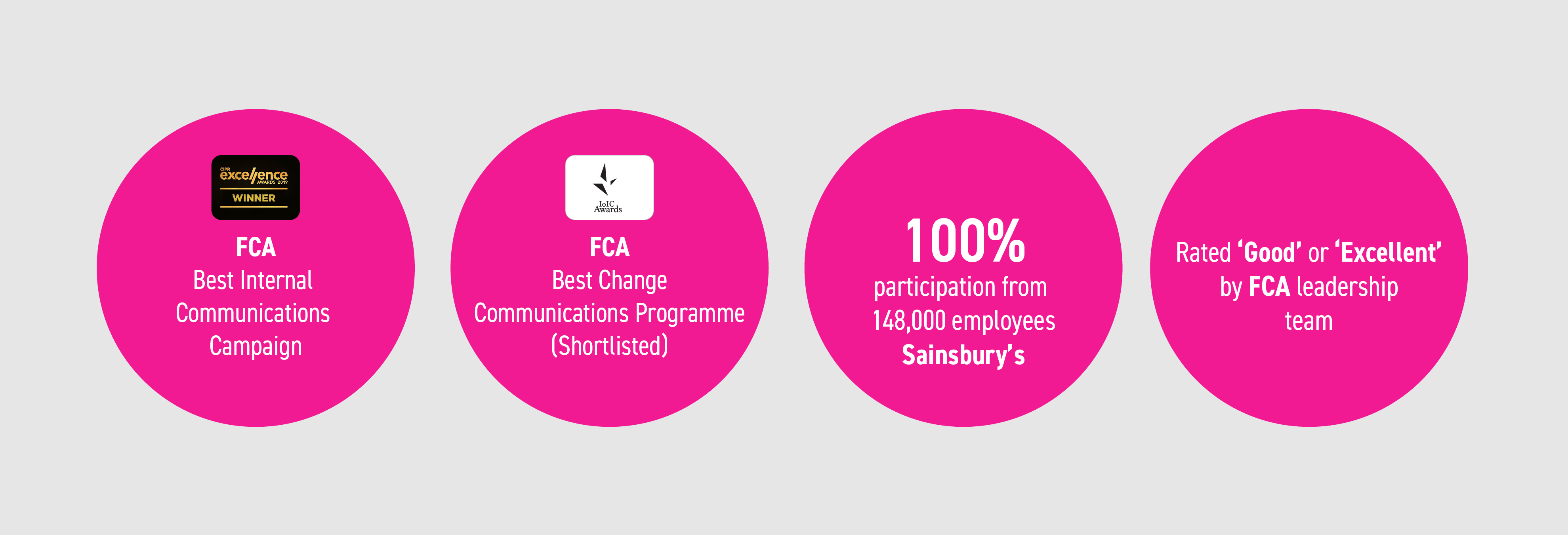

Change and transformation consultancy and services
As a change and transformation communications agency, we know organisational change takes many forms. It could be operational – with a change in skills and aptitudes, perhaps embedding a more digital or AI mindset. It might be through mergers and aquisitions where new business units and teams are being formed. Or it might be in location – with a new office acting as a catalyst for different ways of working, more streamlined processes, or adoption of new methods of collaboration.
Whatever your transformation challenge, effective and impactful communication of the need for change needs to be approached carefully, which is where we can help.

Communicating organisational change
With more than 20 years’ award-winning experience in communicating change management strategies, blue goose is here to help you engage with employees with a clear vision and ensure there is consistent messaging. We’ve supported multiple large and complex organisations such as McDonald’s, Novo Nordisk, Sainsbury’s, Sodexo and Financial Conduct Authority among others, on a variety of change journeys over the years.
Our approach always starts with the same set of questions: Why are you changing? What will it mean for employees? How can they feel they have agency to support it and move with the times?
Answers to these three questions ultimately provide a narrative arc that will inform any communications plan – the why, what, and how of change.
However, having a story to tell is only one part. The structure of any comms approach needs careful consideration.
Senior leaders need to be readied for motion. Organisational structures need to be put in place. Communication messages need to be planned to guarantee employees are brought along the journey, rather than placed at its mercy.
This is where blue goose comes in, to create your communications strategy, frameworks, campaigns and creative assets required for multiple channels.

Talk to our team of specialists today
Change and Transformation Resources: FAQs, Case Studies and Insight
Frequently Asked Questions
Change within any organisation can create a sense of unease and uncertainty amongst employees about the future and their role. Change communications manages employees through the change process by keeping them well-informed and updated throughout the process. This, in turn, helps employees to prepare, understand and adapt to the upcoming changes.
Change communications should offer transparency and peace of mind to employees, with a channel strategy that is guaranteed to reach every employee.
Treat your employees how you would like to be treated – with transparency, honesty and respect throughout the process. A change comms strategy places employees at its heart – helping to keep them informed of the wider plan and roadmap, keeping them engaged throughout the change process. In turn, this keeps them connected to the business in what are considered uncertain times, helping to maintain good morale, maintain productivity and build trust.
As with any narrative, it should be two-way and it’s important for your employees to have a voice too. Any communications strategy should encourage feedback, so employees feel both seen and heard throughout the change process which in turn should help to maintain morale.
The 4 Ps of transition communication are Purpose, Picture, Plan, and Part:
- Purpose: Explain why the change is being implemented and the longer-term benefits.
- Picture: Describe what the future looks like and how it will make employees feel
- Plan: Outline the implementation roadmap, including all stages and what they comprise of.
- Part: Take your employees on the journey and get their support by explaining how they can play their part in making the change a success.
A behaviour change is defined by the modification of existing actions, attitude or approach in their workplace to align with the needs of the business to play their part in improvement. Behaviour change can be individual (for example, developing leadership qualities) or collective (for example, adopting new company-wide processes and systems).
Leaders and managers in a business can help employees embrace behaviour change by working with them to understand any challenges they have, praise them as new habits are adopted and keeping an open narrative about the wider goals and benefits.
Digital transformation is the implementation of new technologies into a business to improve how that business works. It could be hardware, software or a combination of both and will impact the previous work systems and processes.
Digital workplace transformation targets a problem or a goal. It’s not ‘tech for the sake of tech’ – it’s using tech in response to an ongoing issue or sticking point. For example, businesses might identify improvements that could be made to their employee experience, understand the technologies to meet the goal and implement the best system. Digital transformation is not a destination, it’s a journey of continuous improvement that evolves in line with technology.












